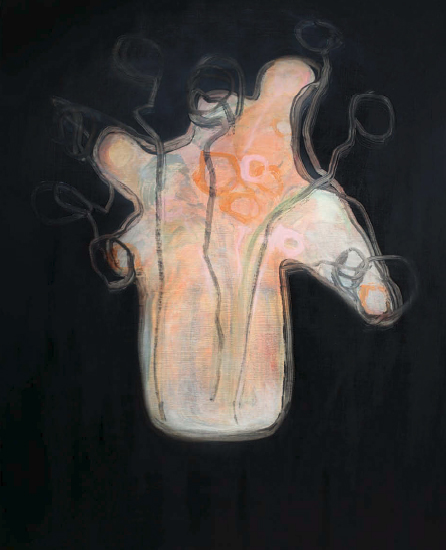- Venue
- Studio 1.1, 57a Redchurch Street, Shoreditch, London E2 7DJ
- Location
- London
The paintings of Miranda Boulton and Suzanne Holtom share a pronounced relationship with the line as a means of moving across and thinking though the picture plane. Off Line/On Line, showing at Studio 1.1 until 2nd November is a selection of recent paintings that clearly suggest the artists’ use of linear constructs to develop an image through the shifting grammars of formal logic and intuition. In both Boulton and Holtom’s works lines appear as important compositional devices – translated into paint but without eliminating the traces of reflection and decision making underneath. This is distinctly illustrated in Boulton’s painting Before Midday (2015), in which drawn and painted lines and areas of thin, glazed oil colour are seen to be laid down onto the supporting board in translucent layers. Each lightly covered line remains in evidence in the final painting, slowly revealing corrections and deliberations in Boulton’s active and additive process of constructing an image. Both Boulton and Holtom’s work express this similar energy. In Holtom’s work Swamp Legends (2015), she uses her signature technique of dropping threads picked from the warp and weft of the canvas to establish the skeletal form of the composition, which is then worked into with varying fleshy tones of paint to create complex, shifting organic shapes. Off Line/On Line presents a selection of works that feel as close to drawing as a means of thinking as they do strictly resolved paintings.
The Off Line/On Line of the exhibition’s title inherently suggests the dual interpretation of both the drawn line present in the artist’s work and the language of the world seen through the window of the internet. Boulton’s work begins with her sourcing images on line, often focusing on flora or other traditional still-life subjects. From these starting points she develops the natural shapes of the flowers into her layered compositions, which suggest figuration yet do not describe specific forms, seen clearly in the luminous, suspended subject in her painting Middle of the Night (2015). The twisted, bulging contours in Holtom’s paintings are informed by her studying stuffed and bottled specimens in the collection of the Grant Museum of Zoology. Both artists use paint’s capacity to engage illusionism to full effect, using images mediated by the surface of the screen or the curved glass of a specimen jar from which to create something that does not exist yet presents an actual, physical experience. Holtom’s displaced and painted canvas threads are at once knotted, bloodied arteries and fine, fluid drawn lines suggesting the interior geometries of her paintings. Her work may begin more intuitively than Boulton’s through the process of dropping threads to determine an early compositional framework, but the resultant image achieves a similar effect of an abstracted natural form; the contorted paint covered shapes and raw bodily tones appear, like Boulton’s subjects, as remote, disembodied figuration. Her work suggests a point at which technology and the body meet: her images feel present yet detached, like watching visual information at a distance, on a screen.
In both artists’ paintings we get a sense of concurrently looking down through the layered image, and looking across and into the paintings’ subjects. This awareness of multiple viewpoints is something we are becoming accustomed to in a world dominated by the consumption of images on a screen. In her essay In Free Fall: A Thought Experiment on Vertical Perspective Hito Steyerl discusses how our sense of spatial and temporal orientation has changed in recent years, incited by new technologies of surveillance and tracking. Steyerl attributes this to the growing prevalence of aerial views on screen, such as those from satellites and Google Maps; she refers to this ‘God’s-eye view’ as a new way of seeing that has started to replace linear perspective as the dominant paradigm of visuality. The overlapping panes of line and form in both Boulton and Holtom’s work reference our contemporary ways of viewing the world, but both artists reintroduce a more visceral experience of seeing through their material manipulation of paint, which embraces the spectrum of liquidity and dryness, opacity and translucence – at odds with the durable plastic of computer hardware and the brilliant glare of the computer monitor.
Off Line/On Line presents the two artists’ work in separate areas of the gallery. Holtom’s work, in particular, forms a series of impressive viewpoints in the exhibition space. Her largest canvases, at 185cm x 150cm, are the most immersive, enabling a more complete understanding of Holtom’s intense reworking and material interventions with the canvas. Boulton’s painted series are hung closely together, forming an intense arrangement of illuminated forms on black grounds, which reference both Dutch still lives and handheld, backlit devices. The titles of these paintings often reference points of the day or night, suggesting the passage of time in an unexplained narrative. Richard Serra’s declaration that ‘drawing is a verb, not a noun’, reinforces that drawing is a dynamic endeavour rather than a static, fixed activity. In Boulton and Holtom’s work the lingering presence of the drawn line also reminds us that painting is a temporal process. To perceive each image in Off Line/On Line fully takes a prolonged time: we are forced to slow down to enter the speed of each individual painting, thereby countering the velocity and ubiquity of the on line, digital image.

